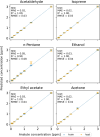Ultratrace eNose Sensing of VOCs toward Breath Analysis Applications Utilizing an eNose-Based Analyzer
- PMID: 38645578
- PMCID: PMC11027196
- DOI: 10.1021/acsmeasuresciau.3c00053
Ultratrace eNose Sensing of VOCs toward Breath Analysis Applications Utilizing an eNose-Based Analyzer
Abstract
This proof-of-principle study presents the ability of the recently developed iLovEnose to measure ultratrace levels of volatile organic compounds (VOCs) in simulated human breath based on the combination of multiple gas sensors. The iLovEnose was developed by our research team as a test bed for gas sensors that can be hosted in three serially connected compact low-volume and temperature-controlled compartments. Herein, the eNose system was equipped with conventional semiconducting metal oxide (MOX) gas sensors using a variety of base technologies providing 11 different sensor signals that were evaluated to determine six VOCs of interest at eight low to ultralow concentration levels (i.e., ranging from 3 to 0.075 ppm) at humid conditions (90% rh at 22 °C). The measurements were randomized and performed four times over a period of 2 weeks. Partial least-squares regression analysis was applied to estimate the concentration of these six analytes. It was shown that the iLovEnose system is able to discriminate between these VOCs and provide reliable quantitative information relevant for future applications in exhaled breath analysis as a diagnostic disease detection or monitoring device.
© 2024 The Authors. Published by American Chemical Society.
Conflict of interest statement
The authors declare no competing financial interest.
Figures
References
-
- Musa-Veloso K.; Likhodii S. S.; Rarama E.; Benoit S.; Liu Y. M. C.; Chartrand D.; Curtis R.; Carmant L.; Lortie A.; Comeau F. J. E.; et al. Breath Acetone Predicts Plasma Ketone Bodies in Children with Epilepsy on a Ketogenic Diet. Nutrition 2006, 22 (1), 1–8. 10.1016/j.nut.2005.04.008. - DOI - PubMed
-
- Török P.; Brudvig L. A.; Kollmann J.; Price J. N.; Tóthmérész B. The Present and Future of Grassland Restoration. Restor. Ecol. 2021, 29 (S1), e1337810.1111/rec.13378. - DOI
LinkOut - more resources
Full Text Sources

